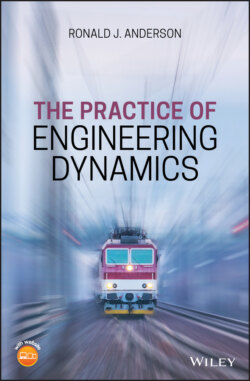Читать книгу The Practice of Engineering Dynamics - Ronald J. Anderson - Страница 10
ОглавлениеPreface
The design of a mechanical system very often includes a requirement for dynamic analysis. During the early concept design stages it is useful to create a mathematical model of the system by deriving the governing equations of motion. Then, simulations of the behavior of the system can be produced by solving the equations of motion. These simulations give guidance to the design engineers in choosing parameter values in their attempt to create a system that satisfies all of the performance criteria they have laid out for it.
There is a logical progression of analyses that are required during the design. The design engineer needs to determine, from the nonlinear differential equations of motion:
The equilibrium states of the system – these are places where, once put there and not disturbed, the system will stay. The time varying terms are removed from the differential equations of motion, leaving a set of nonlinear algebraic equations. The solutions to these equations provide knowledge of all of the equilibrium states.
The stability of the equilibrium states – the question here is: if the system is disturbed slightly from an equilibrium state, will it try to get back to that state or will it move farther away from it? It is usually not good practice to design systems around unstable equilibrium states since the system will always tend to move towards a stable equilibrium condition. Answering the stability question involves a linearization of the equations of motion for small perturbations away from the equilibrium states.
How the system behaves around a stable equilibrium state – the study of small motions of a mechanical system around a stable equilibrium state lies in the realm of vibrations and leads to predictions of natural frequencies, mode shapes, and damping ratios, each of which is very useful during the design process. The linearized differential equations of motion are used.
The response to harmonically applied external forces – systems, in stable equilibrium, are often subjected to harmonic external disturbances at known forcing frequencies and their response to these forces provides critical design information. The linearized equations of motion are used.
The response of the system in the time domain – the fully nonlinear equations of motion are solved numerically to simulate the response of the system to known external forces. Large scale motions and the nonlinear characteristics of system elements are included. This is the numerical equivalent to conducting performance experiments with a prototype of the system. The design information gleaned from these simulations is, perhaps surprisingly to some, not very useful in the early stages of the design. Accurate nonlinear simulations require precise knowledge of system parameters that simply isn't available in the early design phases of a project. The time domain simulations are best left to the prototype testing stage when they can be validated through comparison of predicted and measured system response. Validated time domain simulations are valuable tools to use when considering design changes aimed at improving the measured performance of the system.
The presentation of material in this book divides the practice of engineering dynamics into three parts.
Part 1. Modeling: Deriving Equations of Motion
Dynamic analysis is based on the use of accurate nonlinear equations of motion for a system. Deriving these complicated equations is a task that is prone to error. Because of this, it is important to derive the governing equations twice, using two different methods of analysis, and then prove to yourself that the two sets of equations are the same. This is a time consuming activity but is vital because predictions made from the equations of motion are critical in the design process. Predictions made using equations with errors are not of any use. The first part of the book discusses the generation of nonlinear equations of motion using, firstly, Newton's laws and, secondly, Lagrange's equation. Only when the two methods give the same equations can the analyst proceed to part 2 with confidence.
Part 2. Simulation: Using the Equations of Motion
The second part presents a logical progression of analysis techniques and methods applied to the governing equations of motion for systems. The progression is from equilibrium solutions that find in what states the system would like to be, to analyzing the stability of these equilibrium states (stability is usually considered only in textbooks on control systems but it is vitally important to dynamic systems), to considering small motions about the stable equilibrium states (this topic is covered in textbooks on vibrations but is, again, vital to engineers doing dynamic analysis), to frequency domain analysis (vibrations again), and finally to time domain solutions (these are rarely covered in textbooks).
Part 3. Working with Experimental Data
While not usually considered a part of the design process, analysis of experimental data measured on dynamic systems is critical to creating a successful product. To assist engineers in developing capabilities in this area, part 3 covers the practical use of discrete fourier transforms in analyzing experimental data.
In order to emphasize the idea that any dynamic mechanical system can be analyzed using the sequence of steps presented here, all the exercises at the ends of the chapters are based on 23 mechanical systems defined in an appendix. Any one of these systems could be used as an example of all of the types of dynamic analysis.
This book is based on course notes that I have developed while teaching a one‐semester graduate course on dynamics over more than two decades. It could just as well be used in a senior undergraduate dynamics course.
November, 2019
Ronald J. Anderson Kingston, Canada
